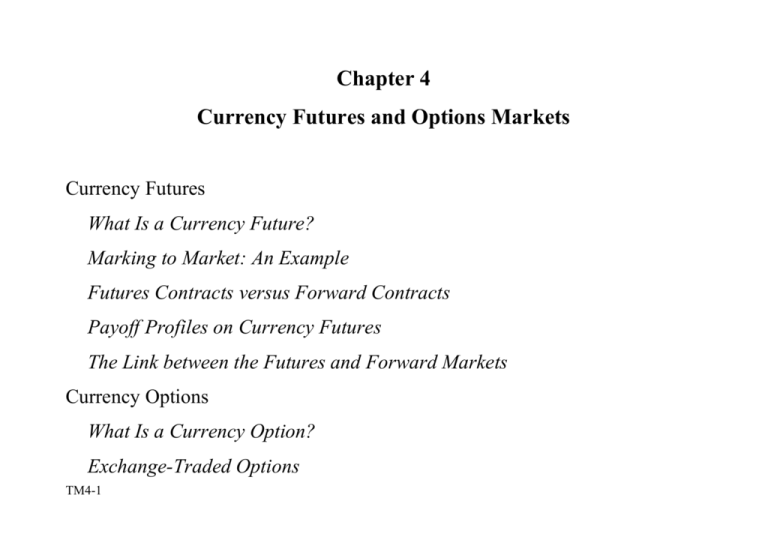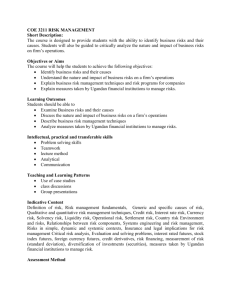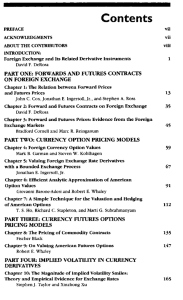Chapter 4
advertisement

Chapter 4 Currency Futures and Options Markets Currency Futures What Is a Currency Future? Marking to Market: An Example Futures Contracts versus Forward Contracts Payoff Profiles on Currency Futures The Link between the Futures and Forward Markets Currency Options What Is a Currency Option? Exchange-Traded Options TM4-1 Quotation Conventions and Market Organization Determinants of the Market Values of Currency Options Over-the-Counter (OTC) Options Payoff Profiles for Currency Options Forwards, Futures, and Options Compared: A Summary TM4-2 Currency Futures: What Is a Currency Future? 1. Currency futures are standardized contracts that trade on the floor of a future exchange. (1) Buyers and sellers, brokers, clearing corporation of a future exchange (2) Currency futures markets For example: the International Money Market (IMM) of the Chicago Mercantile Exchange the COMEX commodities exchange in New York the Chicago Board of Trade the London International Financial Futures Exchange (LIFFE) 2. Currency futures contracts are traded in TM4-3 (1) a few value dates For example: At the Chicago IMM, there are four value dates of contracts: the third Wednesday in the months March, June, September, and December. (delivery of the underlying foreign currency occurs 2 business days after the contract matures) (2) specific sizes For example: £62,500, Can$ 100,000, etc. (refers to Figure 4.1) (3) Figure 4.1 Currency Futures Quotations on the International Money Market of the Chicago Mercantile Exchange, February 17, 1994 ◎ future prices of foreign currencies are quoted as U.S. dollar equivalents (as U.S. dollars per unit of foreign exchange) TM4-4 ◎ open, high, low, settle, change, lifetime high, lifetime low, open interest ◎ To convert these per-unit prices into futures contract prices it is necessary to multiply the prices in the table by the contract amounts. For example: the price of one Japanese yen March contract is $0.009593/¥ * ¥12,500,000 = $ 119,912.50 ◎If we assume risk neutrality, the per-unit price of futures equals the market’s expected future spot rate of the foreign currency. It is changes in the market’s expected future spot exchange rate that drive futures contract prices up and down. 3. Margin TM4-5 (1) Both buyers and sellers of currency futures must post a margin and pay a transaction fee. (2) Maintenance level: Margins must be supplemented by contract holders and brokerage houses if the amount in a margin account falls below a certain level, called the maintenance level. For example: the IMM’s required minimum margin on British pounds is currently $2,000 per contract, and its maintenance level is $1,500. (3) Marking to Market: Margin adjustment is done on a daily basis and is called marking to market. TM4-6 Marking to Market: An Example 1. Table 4.1 Settlements on a Pound Futures Contract (1) If the market value of the contract valued at the settle price falls more than $500, the full amount of the decline in value must be added to the clients’ and the brokers’ margin accounts. (2) Declines in contract values which is small enough to leave more than $1,500 of equity do not require action. (3) Increases in the values of contracts are added to margin accounts and can be withdrawn. 2. When the buyer’s account is adjusted up, the seller’s account is adjusted down the same amount. TM4-7 Futures Contracts versus Forward Contracts 1. Margin Requirement (1) For forward contracts: Types of clients ◎ Interbank transactions and transactions with large corporate clients: Banks require no margin ◎ Clients with a credit line: Banks are likely to reduce the credit line ◎ Clients without a credit line: Banks require a margin account and the margin may be called (2) What instruments will be accepted as margin ◎ Forward contracts: Very flexible TM4-8 ◎ Futures contracts: A substantial part of initial margin may be accepted in the form of securities, such as treasury bills, but subsequent maintenance payments are typically in cash. (which could be viewed as an opportunity cost associated with futures contracts) 2. Foreign Exchange Risk with futures contracts (1)Most of the foreign exchange risk is removed. The possible gain in a futures contract will compensate for the higher-than-expected spot exchange rate in the future. (2) Marking-to-market risk The marking-to-market risk is due to the variability in interest rates. (3) The contract size is fixed TM4-9 The contract size of a futures contract is unlikely to correspond exactly to a firm’s needs. 3. The flexibility in values of forward contracts and in margin maintenance, as well as the absence of marking-to-market risk, make forwards preferable to futures for importers, exporters, borrowers, and lenders who wish to precisely hedge foreign exchange risk and exposure. Currency futures are more likely to be preferred by speculators because gains on futures contracts can be taken as cash and because the transaction costs are small. TM4-10 Payoff Profiles on Currency Futures 1. The consequences of unanticipated changes in the spot exchange rate on the contract value and margin account of a purchaser of Deutschemark futures. Table 4.2 Unanticipated Changes in Spot Rates and Futures to Buy Deutschemarks. Figure 4.2 Payoff Profile on Purchase of Deutschemark Futures (1) the market’s expected future spot rate: DM1.80/$ in the usual European terms the futures market price: $0.5556/DM (= 1÷DM1.80/$) the market price of a futures contract: $0.5556/DM * DM125,000 = $69,450 TM4-11 (2) Fuzzy: “±” in the last column means the uncertainty in precise payoffs. For example: If money has been withdrawn and invested, there might be more than the gain shown in the margin account. 2. The payoffs for the sale of futures are the numbers in the final column of Table 4.2, with the signs reversed, and the consequent payoff profile is an upward-sloping fuzzy line. TM4-12 The Link between the Futures and Forward Contracts 1. The interdependence between the futures and forward contracts is the result of the action of arbitragers who can take offsetting positions in the two markets when prices differ. 2. Arbitrage will ensure that the bid price of forward currency does not exceed the ask price of currency futures, and vice versa. 3. The forward market can influence the futures market, and vice versa. TM4-13 Currency Options: What Is a Currency Option? 1. Unlike forward and futures contracts, currency options give the buyer the opportunity, but not the obligation, to buy or sell at a preagreed price—the strike price, or exercise price—in the future. TM4-14 Exchange-Traded Options: Futures Options versus Spot Options 1. Futures Options (1) Futures options give the buyers the right but not the obligation to buy or sell currency futures contracts at a preagreed price. Such options trade at the IMM in Chicago. (2) Options on futures derive their value indirectly from the expected future spot value of the underlying currency. 2. Spot Options (1) Spot options give the buyers the right to buy or sell the currency itself at a preagreed price. Such options trade on the Philadelphia Exchange. (2) Spot options derive their value directly from the expected future spot value of the underlying currency. TM4-15 Characteristics of Spot Currency Options 1. The variety of currency options and the sizes of contracts British pound 31,250 German mark 62,500 Australian dollar 50,000 Canadian dollar 50,000 French franc 250,000 Japanese Yen 6,250,000 Swiss franc 62,500 The European Currency Unit (ECU) 62,500 2. European Options versus American Options (1) European options: European options can be exercised only on the maturity date of the option. They cannot be exercised before that date. TM4-16 (2) American options: American options offer buyers more flexibility in that they can be exercised on any date up to and including the maturity date of the option. 3. The Expiring Months and Dates (1) The expiring months: March, June, September, and December, plus one or two near-term months. (2) The expiring dates: ◎ Mid-month options: Most options expire on the Friday before the third Wednesday of the expiry month. ◎ End-of-month (EOM) options: These expire on the last Friday of the month. TM4-17 4. The Strike Prices (1) The strike price (exercise price) gives the exchange rate at which the option buyer has the right to buy or sell the foreign exchange. (2) Call option: A call option gives the buyer the right to buy the foreign currency at the strike price or exchange rate on the option. (3) Put option: A put option gives the buyer the right to sell the foreign currency at the strike price. 5. An Example German Mark 58.60 62,500 German marks – European Style Puts 58 Mar Vol. Last 600 0.26 (1) 58.60: $0.5860/DM, the spot exchange rate TM4-18 (2) 58: the strike price for this put option (3) 0.26: the price of the option, 0.26 U.S. cents per mark (4) For the contract of 62,500 German marks the option buyer must pay $0.0026/DM * DM62,500 = $162.50 6. The Spot Exchange Rate versus the Strike Price (1) For call options In the money: the strike price < the spot rate Out of the money: the strike price > the spot rate At the money: the strike price = the spot rate (2) For put options In the money: the strike price > the spot rate Out of the money: the strike price < the spot rate At the money: the strike price = the spot rate TM4-19 7. The Option Premium (1) The option premium is the amount paid for the option on each unit of foreign currency. This premium consists of two parts: the intrinsic value, if there is any, and the time value. (2) The intrinsic value is how many cents per foreign currency would be gained by exercising the option immediately. (3) The time value is the part of the premium that comes from the possibility that, at some point in the future, the option might have higher intrinsic value than at that moment. TM4-20 Quotation Conventions and Market Organization 1 Quotation Conventions Option dealers quote a bid and ask premium on each contract. A dealer must state whether a bid or ask premium is for a call or put, whether it is for American or European option, the strike price, and the month the option expired. 2 Margin (1) For buyers: After the buyer has paid for an option contract, he or she has no financial obligation. There is no need to talk about margins for buyers. (2) For sellers (writers): The writers of a call option must stand ready, when required, to sell the currency to the option buyer at the strike price. The option exchange guarantees that option sellers honor their obligations to option buyers and therefore requires option sellers to post a margin. TM4-21 Determinants of the Market Values of Currency Options The Price of Call Options (Put Options) Factors Option Premium 1. Intrinsic Value () 2. Volatility of the Spot Rate () 3. Length of Period to Expiration () 4. Flexibility of Options* () 5. Interest Rate on Currency of Purchase** () 6. The Forward Premium*** () The Forward Discount () Interest Differential () TM4-22 * For a given strike price, exchange-rate volatility, and period to expiration, American options are typically more valuable than European options. ** The higher the interest rate on the currency paid for an option, the lower the present value of the exercise price. A lower exercise price increases the market value of a call and reduces the market value of a put. *** The more the currency is expected to increase in value, that is, the currency tends to trade at a forward premium, the higher the market value of a call option and the lower the market value of a put option on that currency. Relatively high interest rate suggests an expected decline in the value of the currency and , consequently, an increased chance that a put will be exercised. TM4-23 Over-the-Counter (OTC) Options 1 Many over-the-counter options written by banks are contingent upon such outcomes as whether a corporate takeover or bid on a foreign project is accepted. That is, the buyer of the option purchases the opportunity to buy a foreign currency at a given strike exchange rate if, for example, a particular takeover occurs. 2 An option that is contingent upon completion of a takeover might be cheaper than a traditional exchange-traded option because the writer of a call contingent on completion of a takeover or a bid on a foreign project does not deliver foreign exchange if the foreign currency increases in value but the deal is not completed. 3 The bank gains because it reinsures by buying an exchange-issued call option to cover the call it has written, and the exchange call increases in value without the need to deliver the foreign currency if the takeover offer is rejected. TM4-24 Payoff Profiles for Currency Options 1. Payoff Profile for Call Option Buyers Table 4.3 and Figure 4.4 2. Payoff Profile for Call Option Writers Table 4.3 and Figure 4.5 3. Payoff Profile for Put Option Buyers Table 4.4 and Figure 4.6 4. Payoff Profile for Put Option Writers Table 4.4 and Figure 4.7 TM4-25 Forwards, Futures, and Options Compared: A Summary Table 4.5. Forwards, Futures, and Options Compared TM4-26






